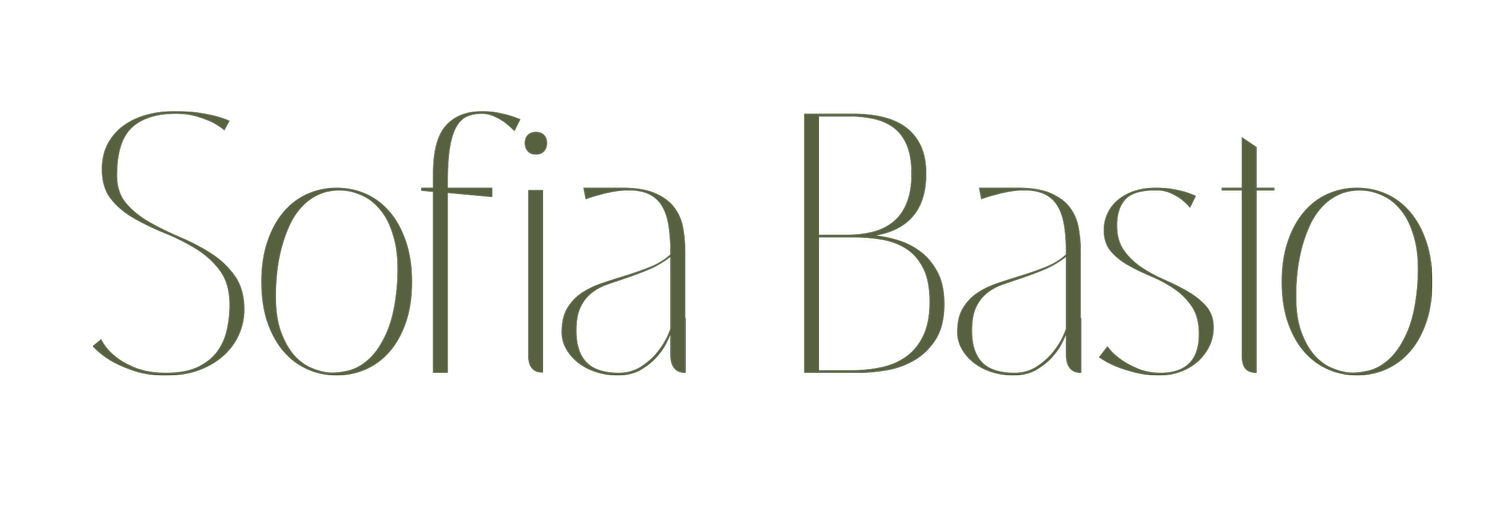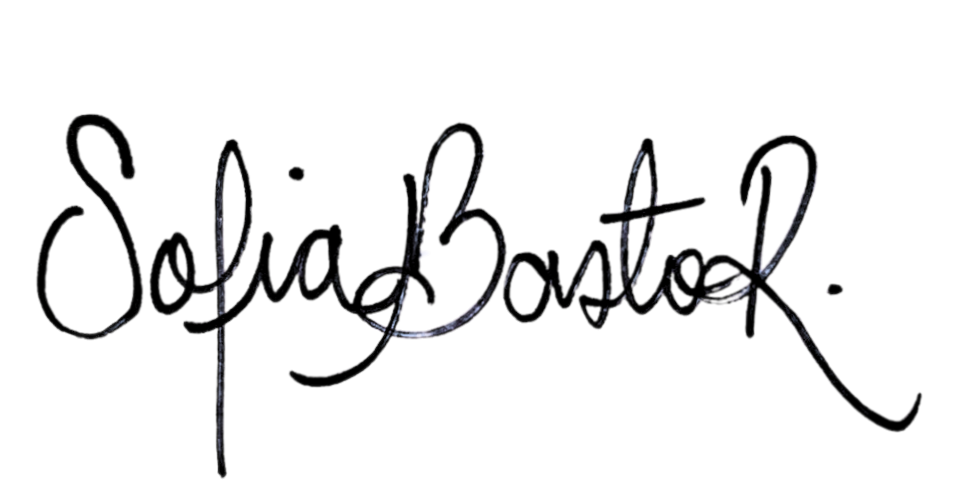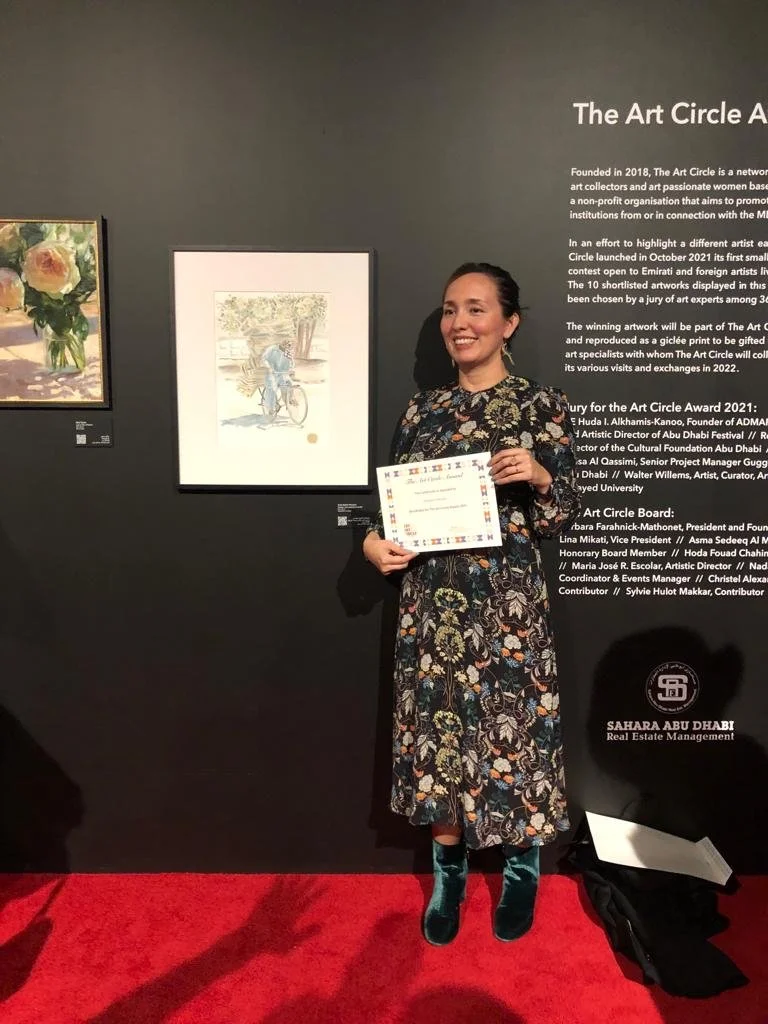Sofia Basto Riousse es una artista colombo-francesa radicada en Dubái desde 2015.
Exabogada que cambió los códigos legales por la poesía visual, su práctica gira en torno al ejercicio contemplativo de encontrar trascendencia en lo cotidiano. A través de naturalezas muertas con frutas de mercado, objetos domésticos bordados y estudios en acuarela de flores marchitas, eleva lo efímero del día a día en meditaciones sobre el tiempo, el lugar y el sentido de pertenencia.
Trabajando entre murales, caligrafía y pintura mixta, Basto Riousse emplea materiales orgánicos —pigmentos minerales, hilos, botánicos tropicales— para tender puentes entre su infancia andina y su entorno actual en el desierto. Un cuenco de lulos se convierte en una reliquia; una mancha de café bordada traza la memoria; una repisa con hierbas en macetas se transforma en un bosque sagrado. Estas escenas silenciosas, a menudo cargadas de yuxtaposiciones surrealistas, invitan al espectador a reconsiderar sus propios rituales diarios como espacios de asombro íntimo.
Su obra ha sido expuesta internacionalmente, manteniendo siempre un diálogo con los paisajes que la formaron: los trópicos colombianos donde presenció por primera vez la alquimia lenta de la naturaleza, las calles parisinas donde estudió las coreografías de la luz, y ahora los Emiratos, donde las arenas cambiantes reflejan su continua exploración de la impermanencia.
“Pinto como se cuidan las plantas: con la certeza de que lo ordinario, al observarse de cerca, revela su estructura extraordinaria.
“Arraigada en lo salvaje, cultivada con intención.”
My work is an exploration of the sacred within the ordinary, an ode to the everyday beauty that often goes unnoticed. Through painting, embroidery, and mixed media, I weave together botanical elements, womanhood, and ancestral memory rooted in Colombia to create a visual language that speaks of belonging, nostalgia, and the profound entanglement between humans and nature.
Rooted in the tropics yet shaped by an ever-shifting sense of place, my practice is a meditation on how geography imprints itself on our perception of the self. The landscapes I’ve crossed over the past 20 years—dense jungles in south east Asia, manicured European gardens, and the vast silence of the Arabian Gulf desert—have all left their mark, not just as backdrops but as active forces shaping perception. In contrast to the humid abundance of my geographical origins, where green erupts in relentless waves, I’ve learned to see the poetry in restraint: the pared-down palette of winter branches, the way desert light turns sand into gold at dusk. These encounters live in my work as quiet negotiations between memory and adaptation, between the flora I was born to and the ecosystems I’ve traversed.
The natural world holds a deeply feminine essence. Pacha Mama—the Quechua concept of Mother Earth—lies at the heart of my visual language. The act of nurturing plants, traditionally entrusted to women in my Andean family, mirrors my creative process itself: a slow, deliberate cultivation of life and meaning. My paintings merge the human and the botanical, questioning the assumed hierarchy between species. These juxtapositions dissolve borders between the cultivated and the wild, the native and the foreign, the self and the landscape.
My practice honors the ‘still life’ not as a frozen tableau, but as a chronicle of the ephemeral. I am drawn to the involuntary poetry of objects suspended in transience: a jar of water half-filled and forgotten, a flower wilting in a vase, fruits in supermarket aisles. These moments—fleeting yet weighted with the residue of human touch—are archaeologies of the everyday, where the mundane becomes a vessel for memory. Unlike the French ‘nature morte’, which fixates on decay, I seek the quiet persistence humming beneath surfaces. Through layered textures of acrylic and embroidery, I render these scenes tactile, as if the objects themselves might whisper stories of hands that grasped them, spaces they briefly occupied, light that softened their edges. Here, stillness is not passivity; it is resistance against the erasure of what we deem disposable.
My landscapes are not idyllic escapes but living geographies where memory and resistance intertwine. In them, the ‘Musa paradisiaca’ (banana flower)emerges as both survivor and narrator. Its violet, architectural bracts rise from lands scarred by cycles of harvest and abandonment. This plant, entwined with the colonial violence of “banana republics,” is not exoticized; it is a witness. I paint its spiraled forms and frayed leaves with pigments mixed from soil, embedding history’s grit into each stroke.
Technique-wise, my process has been empirical, patient, very much grounded in trial-and-error. I work primarily with acrylic, watercolors, and textiles, allowing materials to guide me as much as concepts. A rigorous treatment oflight, colorimetry, and attention to organic subjects dominate my compositions, bending toward the surreal to disrupt the familiar and reveal its hidden magic. Vines coming out from seashells, body parts blending with a jungle, reflecting how places layer themselves in the mind long after we’ve left them.
Ultimately, my artistic practice is an act of reverence: for the land, the past, and the quiet rituals that sustain us. It is a call to look closer, to find the extraordinary in the mundane, and to remember that we are not separate from nature but woven into its endless, evolving tapestry.
Artist statement

¿Te interesa recibir nuestro catálogo, comprar una obra o participar en un taller? ¡Nos encantaría saber de ti!
No dudes en escribirnos con tus preguntas, consultas o ideas de colaboración — estamos aquí para ayudarte.





